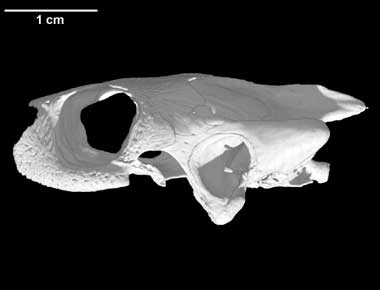Emys orbicularis, the European pond turtle, is a member of Emydidae within Cryptodira. Emys orbicularis is the only member of Emydidae that occurs in the Old World, and is also the only turtle to occur throughout most of Europe (Ernst and Barbour, 1989; Bonin et al., 2006). Emydidae contains the most species of any turtle group, and has an evolutionary record stretching back 80 million years (Ernst and Barbour, 1989; Bonin et al., 2006). Emydidae is closely related to the Old World pond turtles and tortoises (Geoemydidae and Testudinidae, respectively), but the relationship of these three close relatives to other turtles is unclear (e.g., Gaffney and Meylan, 1988; Joyce, in press).
Emys orbicularis is of medium  size, reaching a carapace length of 21 cm (Ernst and Barbour, 1989; Bonin et al., 2006). The skull is relatively small and exhibits extensive emargination. There is a double articulation between the fifth and sixth cervical vertebrae (Ernst and Barbour, 1989). The carapace is oval and somewhat flattened. The plastron is well developed and a hinge is present between the hyo- and hypoplastra. The digits are webbed, and the tail is relatively long. Dorsally, E. orbicularis ranges from olive-brown to black, and exhibits yellow radiations or dots. The plastron ranges from black to yellow, and each scute has a black border. Males have red eyes, while females have yellow eyes (Ernst and Barbour, 1989; Bonin et al., 2006).
size, reaching a carapace length of 21 cm (Ernst and Barbour, 1989; Bonin et al., 2006). The skull is relatively small and exhibits extensive emargination. There is a double articulation between the fifth and sixth cervical vertebrae (Ernst and Barbour, 1989). The carapace is oval and somewhat flattened. The plastron is well developed and a hinge is present between the hyo- and hypoplastra. The digits are webbed, and the tail is relatively long. Dorsally, E. orbicularis ranges from olive-brown to black, and exhibits yellow radiations or dots. The plastron ranges from black to yellow, and each scute has a black border. Males have red eyes, while females have yellow eyes (Ernst and Barbour, 1989; Bonin et al., 2006).
Emys orbicularis ranges throughout continental Europe, from the Caspian Sea to the Atlantic coast, and occurs in Morocco, Algeria, and Tunisia, and its range formerly included the Scandinavian countries and England (Ernst and Barbour, 1989; Bonin et al., 2006). It prefers slow-moving fresh water bodies with soft bottoms and abundant vegetation. Emys orbicularis is carnivorous, and actively hunts invertebrates, amphibians, and fishes, both in and out of water. Females lay several clutches of three to 16 eggs, and often do not reproduce every year (Ernst and Barbour, 1989; Bonin et al., 2006). Emys orbicularis is listed by the IUCN as near-threatened.

Literature
Bickham, J.W. and J.L. Carr. 1983. Taxonomy and phylogeny of the higher categories of cryptodiran turtles based on a cladistic analysis of chromosomal data. Copeia 1983:918-932.
Bonin, F., Devaux, B., and A. Dupré. 2006. Turtles of the World. Translated by P.C.H. Pritchard. Johns Hopkins University Press, Baltimore MD.
Cadi, A. and P. Joly. 2004. Impact of the introduction of the red-eared slider (Trachemys scripta elegans) on survival rates of the European pond turtle (Emys orbicularis). Biodiversity and Conservation 13:2511-2518.
Ernst, C.H. and R.W. Barbour. 1989. Turtles of the World. Smithsonian Institution Press, Washington DC.
Ferri, V. 2002. Turtles and Tortoises. Firefly Books, Willowdale, Ontario.
Ficetola, G.F. and F. De Bernardi. 2006. Is the European "pond" turtle Emys orbicularis strictly aquatic and carnivorous? Amphibia-Reptilia 27:445-447.
Ficetola, G.F., Padoa-Schioppa, E., Monti, A., Massa, R., De Bernardi, F., and L. Bottoni. 2004. The importance of aquatic and terrestrial habitat for the European pond turtle (Emys orbicularis): implications for conservation planning and management. Canadian Journal of Zoology 82:1704-1712.
Gaffney, E.S. 1972. An illustrated glossary of turtle skull nomenclature. American Museum Novitates 2486:1-33.
Gaffney, E.S. 1979. Comparative cranial morphology of recent and fossil turtles. Bulletin of the American Museum of Natural History 164:1-376.
Gaffney, E.S. and P.A. Meylan. 1988. A phylogeny of turtles. In: Benton, M.J., editor. The Phylogeny and Classification of the Tetrapods, Volume 1: Amphibians, Reptiles, Birds. Clarendon Press, Oxford, pp. 157-219.
IUCN 2006. 2006 IUCN Red List of Threatened Species (On-line). Accessed 28 March 2007 at http://www.iucnredlist.org.
Jamniczky, H.A. In press. Turtle carotid circulation: a character analysis case study. Biological Journal of the Linnean Society.
Jamniczky, H.A. and A.P. Russell. 2007. Reappraisal of patterns of nonmarine cryptodiran turtle carotid circulation: evidence from osteological correlates and soft tissues. Journal of Morphology 268:571-587.
Joyce, W.G. In press. A phylogeny of Mesozoic turtles. Bulletin of the Peabody Museum of Natural History.
Lebboroni, M. and G. Chelazzi. 2000. Waterward orientation and homing after experimental displacement in the European Pond Turtle, Emys orbicularis. Ethology Ecology & Evolution 12:83-88.
McDowell, S.B. 1964. Partition of the genus Clemmys and related problems in the taxonomy of aquatic Testudinidae. Proceedings of the Zoological Society of London Series B 143:239-279.
Mitrus, S. 2006. Fidelity to nesting area of the European pond turtle, Emys orbicularis (Linnaeus, 1758). Belgian Journal of Zoology 136:25-30.
Orenstein, R. 2001. Turtles, Tortoises, and Terrapins: Survivors in Armor. Firefly Books, Buffalo, New York.
Pritchard, P.C.H. 1979. Encyclopedia of Turtles. TFH Publishing, Neptune, Florida.
Shaffer, H.B., Meylan, P., and M.L. McKnight. 1997. Tests of turtle phylogeny: molecular, morphological, and paleontological approaches. Systematic Biology 46:235-268.
Links
Emys orbicularis page from the Lithuanian Fund for Nature










